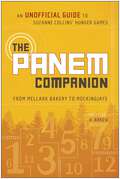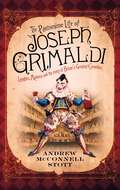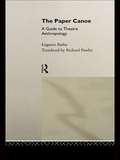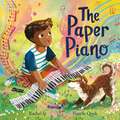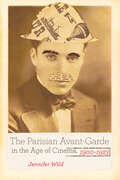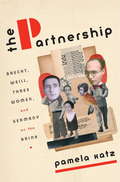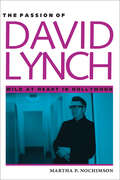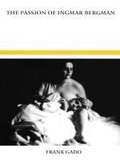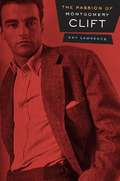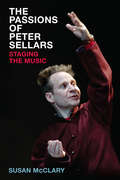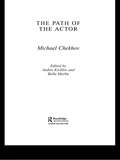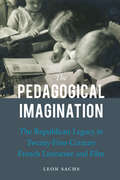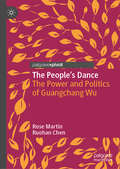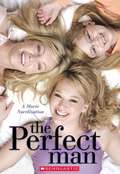- Table View
- List View
The Panem Companion: An Unofficial Guide to Suzanne Collins' Hunger Games, From Mellark Bakery to Mockingjays
by V. ArrowGo deeper into the home of the Hunger Games with the creator of the best-known fan map of Panem What does Panem look like? How does Panem define race? How do Panem's districts reflect the major themes of the trilogy? What allusions to our world are found in Panem names like Finnick, Johanna, Beetee, Cinna, Everdeen, and Mellark? The Panem Companion gives fresh insight into Suzanne Collins' trilogy by looking at the world of the Hunger Games and the forces that kept its citizens divided since the First Rebellion. With a blend of academic insight and true fan passion, V. Arrow explores how Panem could have evolved from the America we know today and uses textual clues to piece together Panem's beliefs about class, ethnicity, culture, gender, sexuality, and more. Includes an extensive name lexicon and color-illustrated unofficial map
The Pantomime Life of Joseph Grimaldi: Laughter, Madness and the Story of Britain's Greatest Comedian
by Andrew McConnell StottThis biography offers a &“vivid portrayal&” of the eighteenth-century English entertainer who &“invented the figure of the classic clown that we know today&” (The Guardian). The son of a deranged Italian immigrant, Joseph Grimaldi (1778–1837) was the most celebrated of English clowns. The first to use white-face makeup and wear outrageous colored clothes, he completely transformed the role of the Clown in the pantomime with a look as iconic as Chaplin&’s Tramp. One of the first celebrity comedians, his friends included Lord Byron and the actor Edmund Kean—and his memoirs were edited by a young Charles Dickens. But underneath the stage paint, Grimaldi struggled with depression, and his life was blighted with tragedy. His first wife died in childbirth, and his son would go on to drink himself to death. The outward joy and tomfoolery of his performances masked a dark and depressing personal life, and instituted the modern figure of the glum, brooding comedian. In this &“exuberant, impassioned portrait,&” biographer Andrew McConnell Stott presents a man who left an indelible mark on the English theatre and the performing arts, but whose legacy is one of human struggle, battling demons and giving it his all in the face of adversity (The Guardian).
The Paper Canoe: A Guide to Theatre Anthropology
by Eugenio BarbaFirst published in 1994. Routledge is an imprint of Taylor & Francis, an informa company.
The Paper Piano: An inspirational picture book for music lovers
by Rachel IpWhen Noah hears beautiful piano music sweeping through the station, he longs to play. Without a pianoof his own, he carefully crafts one out of paper, and the notes fill his head night and day. Until finally, with the help of a neighbour, his musical dream comes true . . .An inspirational picture book about the power of perseverance and music, celebrating the joy that railway station pianos can bring to all. Written by award-winning author Rachel Ip, with artwork from award-winning illustrator Natelle Quek.
The Parasite
by Ramsey CampbellTwenty years after a game of Ouija ends in a ten-year-old's disappearance, Rose Tierney discovers that she has developed psychic powers that enable her to see into the future and travel without her body, but that make her vulnerable to an evil force.
The Parisian Avant-Garde in the Age of Cinema, 1900-1923
by Jennifer WildThe first decades of the twentieth century were pivotal for the historical and formal relationships between early cinema and Cubism, mechanomorphism, abstraction, and Dada. To examine these relationships, Jennifer Wild’s interdisciplinary study grapples with the cinema’s expanded identity as a modernist form defined by the concept of horizontality. Found in early methods of projection, film exhibition, and in the film industry’s penetration into cultural life by way of film stardom, advertising, and distribution, cinematic horizontality provides a new axis of inquiry for studying early twentieth-century modernism. Shifting attention from the film to the horizon of possibility around, behind, and beyond the screen, Wild shows how canonical works of modern art may be understood as responding to the changing characteristics of daily life after the cinema. Drawing from a vast popular cultural, cinematic, and art-historical archive, Wild challenges how we have told the story of modern artists’ earliest encounter with cinema and urges us to reconsider how early projection, film stardom, and film distribution transformed their understanding of modern life, representation, and the act of beholding. By highlighting the cultural, ideological, and artistic forms of interpellation and resistance that shape the phenomenology of a wartime era, The Parisian Avant-Garde in the Age of Cinema, 1900–1923 provides an interdisciplinary history of radical form. This book also offers a new historiography that redefines how we understand early cinema and avant-garde art before artists turned to making films themselves.
The Parisian Jazz Chronicles: An Improvisational Memoir
by Mike ZwerinThis book is built around a structure that treats such subjects of my music column in the International Herald Tribune as Dexter Gordon, Freddy Heineken, Miles Davis, Bob Dylan, Chet Baker, and Melvin Van Peebles as though they were the written notes in big band arrangements.
The Parks and Recreation: Official Cookbook
by Jenn FujikawaPrepare to treat yo self! Parks and Recreation: The Official Cookbook is the ultimate way for fans to visit the kitchens, restaurants, and Harvest Festivals of Pawnee, IN, without ever leaving their homes. And though &“there has never been a sadness that can&’t be cured by breakfast food,&” home cooks of every skill level will be able to recreate meals for any time of day, including: Leslie Knope&’s Favorite JJ&’s Diner Waffles Eagleton Crepes Ron Swanson&’s Meat Tornado Burrito Paunch Burger&’s Double Bason Grenade Deluxe Chris Traeger&’s Turkey Burger and Literally the Best Salad You&’ve Ever Had Stu&’s Stew April and Andy&’s Most Amazing Grilled Cheese Sandwich Ever Made Ben&’s Calzones And don&’t forget to treat yo self to: Donna&’s Mimosas Marshmallow Ron Swansons Sweetums Sugar Splash Floats Featuring more photos, quotes, and many vegetarian, vegan, and gluten-free options than there are rules to The Cones of Dunshire, Parks and Recreation: The Official Cookbook serves up something for every fan!
The Partnership
by Pamela KatzAmong the most creative and outsized personalities of the Weimar Republic, that sizzling yet decadent epoch between the Great War and the Nazis' rise to power, were the renegade poet Bertolt Brecht and the rebellious avant-garde composer Kurt Weill. These two young geniuses and the three women vital to their work--actresses Lotte Lenya and Helene Weigel and writer Elizabeth Hauptmann--joined talents to create the theatrical and musical masterworks The Threepenny Opera and The Rise and Fall of the City of Mahagonny, only to split in rancor as their culture cracked open and their aesthetic and temperamental differences became irreconcilable. The Partnership is the first book to tell the full story of Brecht and Weill's impulsive, combustible partnership, the compelling psychological drama of one of the most important creative collaborations of the past century. It is also the first book to give full credit where it is richly due to the three women whose creative gifts contributed enormously to their masterworks. And it tells the thrilling and iconic story of artistic daring entwined with sexual freedom during the Weimar Republic's most fevered years, a time when art and politics and society were inextricably mixed.
The Partridge Family (The Partridge Family #1)
by Michael AvalloneCan America's top rock group prevail against the evil machinations of a fat but deadly enemy agent- without blowing their cool? If any group can do it, the Partridge family can! They're a high-voltage six-pack of talent and energy--five groovy kids plus one beautiful, mini-skirted Mom--and they've settled down in the Top Ten for., a long, long stay. Even the coolest clan in rock gets put up-tight when a sinister spymaster hunts them down. He's after an international secret they don't even know they're carrying, and he'll stop at nothing. But little does he know what lies ahead when he tangles with that all-American super-singing weapon, THE PARTRIDGE FAMILY
The Passion of David Lynch: Wild at Heart in Hollywood
by Martha P. Nochimson&“This is the best book on David Lynch that has yet been published. Nochimson&’s book is essential reading for anyone interested in contemporary cinema.&” —Brian Henderson, former chair of the Department of Media Study, State University of New York at Buffalo Filmmaker David Lynch asserts that when he is directing, ninety percent of the time he doesn&’t know what he is doing. To understand Lynch&’s films, Martha Nochimson believes, requires a similar method of being open to the subconscious, of resisting the logical reductiveness of language. In this innovative book, she draws on these strategies to offer close readings of Lynch&’s films, informed by unprecedented, in-depth interviews with Lynch himself. Nochimson begins with a look at Lynch&’s visual influences—Jackson Pollock, Francis Bacon, and Edward Hopper—and his links to Alfred Hitchcock and Orson Welles, then moves into the heart of her study, in-depth analyses of Lynch&’s films and television productions. These include Twin Peaks: Fire Walk with Me, Wild at Heart, Twin Peaks, Blue Velvet, Dune, The Elephant Man, Eraserhead, The Grandmother, The Alphabet, and Lynch&’s most recent, Lost Highway. Nochimson&’s interpretations explode previous misconceptions of Lynch as a deviant filmmaker and misogynist. Instead, she shows how he subverts traditional Hollywood gender roles to offer an optimistic view that love and human connection are really possible. &“Nochimson deftly deploys a mixture of feminist criticism, the Bakhtinian notion of the carnivalesque, and an intriguing blend of Jungian and Freudian concepts to make one of our most complex filmmakers seem quite accessible after all.&” —J. P. Telotte, Film Quarterly
The Passion of Ingmar Bergman
by Frank GadoAcknowledged as one of the greatest filmmakers of this or any other time, Bergman has with few exceptions written his own screenplays--an uncommon practice in the film industry--and for this practice critics refer to him as a "literary" filmmaker: In this work, Gado examines virtually the entire range of Bergman's literary output. While treating the matter of the visual presentation of Bergman's films, Gado concentrates on story and narrative and their relationship to Bergman's personal history.Gado concludes that whatever the outward appearance of Bergman's works, they contain an elementary psychic fantasy that links them all, revealing an artist who hoped to be a dramatist, "the new Strindberg," and who saw the camera as an extension of his pen.
The Passion of Montgomery Clift
by Amy LawrenceChallenging the myth of Clift, actor, as tragic victim, Amy Lawrence explores the way Clift's extraordinary looks, controversial sexuality, and the accident that allegedly changed the course of his career continue to feed the religious intensity of fan discourse.
The Passionate Years
by Caresse CrosbyA mad, amusing, and revealing look at Paris in the twenties and at the people Caresse Crosby knew—Hemingway, F. Scott Fitzgerald, Edith Wharton, James Joyce, Picasso, Ezra Pound, T. S. Eliot, Lawrence of Arabia, and a host of others. In a single day, a visitor to the Crosby home outside of Paris might have found Salvador Dali at work in one room, Douglas Fairbanks Senior playfully swinging from the rafters, and D. H. Lawrence sunning himself by the pool.“In her autobiography Mrs. Crosby has added a valuable footnote to the literary history of our time....She tells some amazingly good stories. Her account of Lindbergh’s arrival in Paris is a superb piece of straight reporting and her description of a Quatre Arts ball at which she won first prize for reasons that cannot be mentioned in a family newspaper is funny and sad at the same time. Her fostering of unknown or otherwise unpublishable writers (Crane, Joyce, D. H. Lawrence, among others) through the Black Sun Press can now be seen clearly for the important project it was.—The New York Times“The Passionate Years becomes immediately an essential document of its era. Also it is an entertaining book.”—New York Herald Tribune
The Passions of Peter Sellars: Staging the Music
by Susan McClaryRecognized as one of the most innovative and influential directors of our time, Peter Sellars has produced acclaimed—and often controversial—versions of many beloved operas and oratorios. He has also collaborated with several composers, including John C. Adams and Kaija Saariaho, to create challenging new operas. The Passions of Peter Sellars follows the development of his style, beginning with his interpretations of the Mozart-Da Ponte operas, proceeding to works for which he assembled the libretti and even the music, and concluding with his celebrated stagings of Bach’s passions with the Berlin Philharmonic. Many directors leave the musical aspects of opera entirely to the singers and conductor. Sellars, however, immerses himself in the score, and has created a distinctive visual vocabulary to embody musical gesture on stage, drawing on the energies of the music as he shapes characters, ensemble interaction, and large-scale dramatic trajectories. As a leading scholar of gender and music, and the history of opera, Susan McClary is ideally positioned to illuminate Sellars’s goal to address both the social tensions embodied in these operas as well as the spiritual dimensions of operatic performance. McClary considers Sellars’s productions of Mozart’s Le nozze di Figaro, Don Giovanni, and Così fan tutte; Handel’s Theodora; Messiaen’s Saint François d’Assise; John C. Adams’s Nixon in China, The Death of Klinghoffer, El Niño, and Doctor Atomic; Kaija Saariaho’s L’amour de loin, La Passion de Simone, and Only the Sound Remains; Purcell’s The Indian Queen; and Bach’s passions of Saint Matthew and Saint John. Approaching Sellars’s theatrical strategies from a musicological perspective, McClary blends insights from theater, film, and literary scholarship to explore the work of one of the most brilliant living interpreters of opera.
The Path Of The Actor
by Michael ChekhovThis is the first English translation of Michael Chekhov’s two-volume autobiography, combining The Path of the Actor (1927) and extensive extracts from his later volume Life and Encounters. Full of illuminating anecdotes and insightful observations involving prominent characters from the MAT and the European theatre of the early twentieth century, Chekhov takes us through events in his acting career and personal life, from his childhood in St. Petersburg until his emigration to Latvia and Lithuania in the early 1930s. Accompanying Chekhov's witty, penetrating, and immensely touching accounts are extensive and authoritative notes compiled by leading Russian Chekhov scholar, Andrei Kirillov. Anglo-Russian trained actor Bella Merlin provides a useful hands-on overview of how the contemporary practitioner might utilise and develop Chekhov's ideas. Chekhov was arguably one of the greatest actors of the twentieth century. His life made a huge impact on his profession, and his actor-training techniques inspired many a Hollywood legend – including such actors as Anthony Hopkins and Jack Nicholson -while his books outlining his teaching methods and philosophy of acting are still bestsellers today The Path of the Actor is an extraordinary document which allows us unprecedented access into the life, times, mind and soul of a truly extraordinary man.
The Path to Paradise: A Francis Ford Coppola Story
by Sam Wasson“Sam Wasson’s supremely entertaining book tracks the ups and downs, ins and outs, of a remarkable career. . . . A marvel of unshowy reportage.”—New York TimesThe New York Times bestselling author of Fifth Avenue, 5 A.M. and The Big Goodbye returns with the definitive account of Academy Award–winning director Francis Ford Coppola’s decades-long dream to reinvent American filmmaking, if not the entire world, through his production company, American Zoetrope.Francis Ford Coppola is one of the great American dreamers, and his most magnificent dream is American Zoetrope, the production company he founded in San Francisco years before his gargantuan success, when he was only thirty. Through Zoetrope’s experimental, communal utopia, Coppola attempted to reimagine the entire pursuit of moviemaking. Now, more than fifty years later, despite myriad setbacks, the visionary filmmaker’s dream persists, most notably in the production of his decades-in-the-making film and the culmination of his utopian ideals, Megalopolis.As Wasson makes clear, the story of Zoetrope is also the story of Coppola’s wife, Eleanor Coppola, and their children, and of personal lives inseparable from artistic passion. It is a story that charts the divergent paths of Coppola and his cofounder and onetime apprentice, George Lucas, and of their very different visions of art and commerce. And it is a story inextricably bound up in the making of one of the greatest quixotic masterpieces ever attempted, Apocalypse Now, and in what Coppola found in the jungles of the Philippines when he walked the razor’s edge. That story, already the stuff of legend, has never fully been told, until this extraordinary book.
The Patriot
by Stephen Molstad Robert RodatIn Britain's American colonies, the cry goes out for freedom as the air from Lexington to the Carolinas burns hot with powder smoke and cannon fire. But Benjamin Martin has had his fill of war. A veteran of the fierce French and Indian conflict, he has renounced fighting forever, retiring to his South Carolina farm to raise his motherless children in peace. Now the war has found his hiding place, bringing its senseless cruelty back into his life and destroying what he holds most dear. And Benjamin Martin must take up arms to fight again--to lead a makeshift army of brave farmers and craftsmen against a relentless, overwhelming enemy--in the blessed cause of liberty. . . and blood vengeance.
The Pedagogical Imagination: The Republican Legacy in Twenty-First-Century French Literature and Film
by Leon SachsFrench school debates of recent years, which are simultaneously debates about the French Republic’s identity and values, have generated a spate of internationally successful literature and film on the topic of education. While mainstream media and scholarly essays tend to treat these works as faithful representations of classroom reality, The Pedagogical Imagination takes a different approach. In this study of French education and republicanism as represented in twenty-first-century French literature and film, Leon Sachs shifts our attention from “what” literature and film say about education to “how” they say it. He argues that the most important literary and filmic treatments of French education in recent years—the works of Agnès Varda, Érik Orsenna, Abdellatif Kechiche, François Bégaudeau—do more than merely depict the present-day school crisis. They explore questions of education through experiments with form.The Pedagogical Imagination shows how such techniques engage present-day readers and viewers in acts of interpretation that reproduce pedagogical principles of active, experiential learning—principles at the core of late nineteenth-century educational reform that became vehicles for the diffusion of republican ideology.
The Penguin Atlas of North American History to 1870
by Colin McevedyThis is a reference to the major developments of North American history from pre-human settlement to the American Civil War and more recent changes. Maps and commentary look at
The People We Watch: Documentary Contributors and What Their Experiences Tell Us About the Cultural Industries (Routledge Studies in Media and Cultural Industries)
by Emily ColemanThe People We Watch explores the politics of contemporary media production from the point of view of the ordinary people it represents.Based upon a series of in-depth interviews and the author’s own professional experience of working in the television industry, this book examines how documentary contributors feel about participating in the media and the ways they are portrayed, considering how their experiences take shape within the structural context of the cultural industries.This insightful text will interest scholars, students, and researchers in media and communication, sociology of the media, documentary studies, and film studies, as well as those studying the cultural industries, media production, creative labour, and cultural policy.The Open Access version of this book, available at www.taylorfrancis.com, has been made available under a Creative Commons Attribution-Non Commercial-No Derivatives (CC-BY-NC-ND) 4.0 International license.Any third party material in this book is not included in the OA Creative Commons license, unless indicated otherwise in a credit line to the material. Please direct any permissions enquiries to the original rightsholder.This work was supported by the Arts and Humanities Research Council [grant number AH/L503848/1]; and the Economic and Social Research Council [grant number ES/Y007808/1].
The People's Machine: Arnold Schwarzenegger and the Rise of Blockbuster Democracy
by Joe MathewsCalifornia voters passed Proposition 13 in 1978. At the same time, a champion bodybuilder named Arnold Schwarzenegger was becoming a movie star. Over the past quarter century, the twin arts of direct democracy (through ballot initiatives designed to push the public to the polls on election day) and blockbuster moviemaking (through movies designed to push the public to the theaters on opening weekend) grew up together, at home in California. With the state's recall election in 2003, direct democracy and blockbuster movies officially merged. The result: Governor Arnold Schwarzenegger. In The People's Machine, political reporter Joe Mathews, who covered Schwarzenegger's gubernatorial campaign for the Los Angeles Times and who has subsequently broken many front page stories about him, traces the roots of both movie and political populism, how Schwarzenegger used these twin forces to win election and, especially, how he has used them to govern. "Let the people decide," said Governor Schwarzenegger after his inauguration. The People's Machine, through remarkable access and whip-smart analysis-there is news in this book-reports on whether this system of governing proves blessing, curse, or mess, and on the remarkable Austrian bodybuilder, movie star, and political man with the nerve to carry it out.
The People’s Dance: The Power and Politics of Guangchang Wu (Critical Studies in Dance Leadership and Inclusion)
by Rose Martin Ruohan ChenThis book presents an analysis of how the grassroots movement of Guangchang Wu or ‘square dance’ in China has become a national phenomenon. Through oral narratives offering rich descriptions of lived encounters, the experiences of those involved in leading, organizing, teaching and learning Guangchang Wu are revealed. Through these narratives, this book serves to understand the leadership practices occurring and how this dance practice is deeply rooted in the complexities of China’s rapid economic development, acceleration of urbanisation, and the desire for a healthier and more communal lifestyle.
The Perfect Amount of Wrong: The Rise of Alt Comedy on Chicago's North Side (The History Press)
by Mike BridenstineIn just over a decade, a tiny, do-it-yourself stand-up scene on the North Side of Chicago produced some of the most successful and influential stand-up comedians of their generation. Hannibal Buress, T.J. Miller, Kyle Kinane, Cameron Esposito, Pete Holmes, Beth Stelling, Matt Braunger and Kumail Nanjiani make up a partial list of names of comics who emerged from a scene that had very little industry attention--or even a home club. It was also a scene that took a backseat to the city's vaunted improv institution, and if we're being completely honest, it was a scene where comics mostly performed to drunks in the backs of dingy bars on their off nights. None of it was glamorous. None of it should have worked at all. But somehow, some way, the comedians from this scene have managed to etch their own names into the Chicago comedy pantheon. The Perfect Amount of Wrong is the story of that scene, as told by its veterans.
The Perfect Man
by Jenny MarkasThe perfect plan for the perfect man . . . Teenager Holly Hamilton is tired of moving every time her single mom, Jean, has another personal meltdown, involving yet another second-rate guy. To distract her mother from her latest bad match, Holly conceives the perfect plan for the perfect man-an imaginary secret admirer who will romance her mom and boost her shaky self-esteem. But when the virtual relationship takes off, Holly finds herself having to produce the suitor, borrowing her friend's charming and handsome uncle Ben as the face behind the e-mails, notes, and gifts. As time passes, Holly must resort to increasingly desperate measures to keep the ruse alive and protect her mom's newfound happiness. But will her dedication to the hoax cause her to miss the real perfect man when he does come along?
